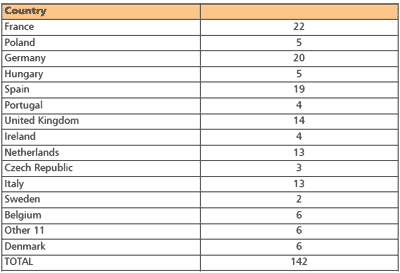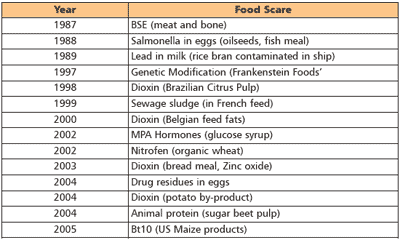Where the EU is heading with food and feed safety and the industry's response
Animal feed manufacture is a significant industry within the European Union as Table 1 demonstrates.
Food safety has been an emotive subject within parts of the European Union, with the media keen to pounce upon any opportunities to publicise adverse occurrences. This has led to newspaper headlines such as "3 million eggs a day may contain toxic drug trace" (Daily Mail, April 2004) or terms such as"Frankenstein Foods".
To some extent the industry has not helped itself by the number of food/ feed scares that have happened in recent years. Table 2 shows some examples of the problems experienced, some of which have been global problems. Virtually all emanate from feed material issues.
Consumer confidence in the safety of the food chain diminished during the 1990s following the catalogue of food and feed scares and both the regulatory authorities and the industry realized that action was needed.
This paper discusses the actions initiated by both the EU Commission and the EU feed industry, and the current scenario within the European Community regarding feed and food safety.
DEVELOPMENT OF THE EU REGULATORY APPROACH
"As a consequence of consumer concern, the EU Commission published the "White Paper on Food Safety" on January 12th 2000. This document outlined the framework for the current approach to regulating food safety in the EU. Its key conclusions were:
• To create an independent European Food Authority to provide a centre for the provision and communication of scientific advice on all aspects of food safety especially risk assessment.
• To ensure logical and comprehensive legislation ensuring a "farm to table" approach and placing responsibility on operators.
• To ensure controls are applied and enforced consistently.
• To update controls on additives, contaminants and novel foods.
• To promote communication to the consumer.
To ensure imported foodstuffs and animal feeds meet the minimum EU legislative standards and that this is discussed with EU trading partners.
| Table 1: Commercial Feed Production within the EU in 2004 (approx million tonnes). |
 |
| Table 2: Examples of food/feed scares experienced in the EU in the last 25 years. |
 |
GENERAL FOOD LAW
Following the "White Paper on Food Safety", Regulation (EC) N° 178/2002 of 28th January 2002 laying down the General Principles of Food Law, was introduced. The purpose of this was to establish food safety as the priority of EU Food Law and have common principles underpinning all food legislation.
Effectively it provides the "umbrella" as regards EU Food Law and several pieces of subsequent legislation followed from it. The main aspects of this legislation, which covers both food and feed, are:
• To provide a common basis for food safety.
• To establish the principles of risk assessment, management and communication.
• To demand traceability (one step up, one step down).
• To make food business operators responsible.
• To establish the European Food Safety Authority.
• To instigate the Rapid Alert System for Food and Feed (RASFF).
The definitions within this legislation are all embracing as "feed" is defined as "any substance or product, including additives, whether processed, partially processed or unprocessed, intended to be used for oral feeding to animals" and" feed business" means "any undertaking, whether for profit or not and whether public or private, carrying out any operation of production, manufacture, processing, storage, transport or distribution of feed, including any producer producing, processing or storing feed for feeding to animals on his own holding."
As indicated earlier, this Regulation demands the use of traceability in addition to risk assessment and management principles. Feed must be"safe" which means that it must neither"have an adverse effect on human or animal health" nor "make the food derived from food-producing animals unsafe for human consumption".
There are some interesting differences between food and feed business operators: if a food product is found to be unsafe, a food business operator has to "withdraw food in question from the market", whereas in a similar situation for a feed business operator, "feed shall be destroyed, unless the competent authority is satisfied otherwise".
FEED HYGIENE REGULATION
A number of pieces of legislation have followed, and one that continues the theme of feed safety in its broadest sense is Regulation (EC) N° 183/2005 of 12th January 2005 laying down requirements for feed hygiene, which will be introduced on 1st January 2006.
Amongst other things, it requires:
• Compulsory registration of all feed business operators.
• HACCP principles to be adopted by all feed businesses other than those engaged in primary production.
• Encouragement to be given to the development of guides to good practice.
Possible provision of financial guarantees to cover situations where operators are liable for the direct consequences of unsafe feed.
OTHER INFLUENCES
Legislation is not the only means by which pressure has been exerted on the feed industry. Consumer confidence has been undermined in recent years, fuelled by the media where the opportunity arises. This has led some of the retailers and other food businesses to take action themselves.
Certainly in the UK, audits of compound feed businesses, especially in the poultry sector, commenced over a decade ago.
Also, farm assurance started to appear and evolve as the farming industry realised that it needed to address its credibility.
The retail industry played a role in this area as EurepGAP originated in 1997 from a number of retailers belonging to Euro Retailer Produce Working Group with the aim of developing "widely acceptable standards and procedures for the global certification of Good Agricultural Practices. On their web-site is a list of Certification Bodies approved to carry out EurepGAP certification to achieve integrated farm assurance.
Similarly, CIES, the global food network, involving 175 retailer and 175 supplier member companies, created Global Food Safety Initiative (GFSI) designed to"strengthen consumer confidence in the food they buy in retail outlets."
GFSI publishes a guidance document which enables benchmarking of standards, including those for agricultural products.
A number of conforming schemes appear on its web-site.
In 2000, FAO started preparing the Codex Code of Practice on Good Animal Feeding, which was adopted last year, and this is currently undergoing its implementation phases. In all of these initiatives, directly or indirectly, the safety of feed is important.
INDUSTRY RESPONSE INDIVIDUAL EU MEMBER STATE RESPONSE
The EU has many member states and until the last year or so, the feed industries and commercial organisations in each country have tended to work independently.
The UK industry is probably a good example of one of the more progressive states. Probably as a consequence of BSE, the UK could not help but recognise the fall in consumer confidence and the need to respond.
In the late 1990"s, the Universal Feed Assurance Scheme (UFAS) for the production of safe animal feed was launched, by the trade association UKASTA, or AIC as it is now. This scheme has evolved ever since and now encompasses 90-95% of compound feed manufacturers in the UK. It is an EN45011 accredited scheme indicating that it is a product safety scheme involving independent auditors working to UKAS (ISO 65) standards.
There is no doubt that it has provided benefit for the trade by giving credence to their manner of operation. It has reduced the number of supplier/retailer audits together with their cost, and has been an extremely useful tool when "selling" the feed industry to regulatory authorities or any other body.
Some members of the UK feed industry were also increasingly concentrating on auditing feed material suppliers as they saw these as being potentially a major source of hazards, ably demonstrated by the feed scares detailed previously in Table 2. This led to an "auditing" club being formed with information being shared, and ultimately, to the development of FEMAS, an accredited certification scheme for feed materials.
Alongside UFAS and FEMAS, assurance codes for merchants, and the growing, storage and transport of combinable crops were also being introduced. These codes when networked with farm livestock codes such as Genesis or Assured British Pigs (ABP) provided an effective assurance for livestock products as piece by piece the jigsaw was put in place.
Assurance schemes have enabled the industry to demonstrate "due diligence" and provided commercial protection. However experience also taught the industry that in order to deliver these benefits, assurance schemes not only needed appropriate written standards but more importantly, needed to have well-trained and rigorous auditors.
Inevitably similar schemes were being developed in other member states and this led to discussions on "mutual recognition" to take place. However, ultimately, the number of schemes together with the advent of the Feed Hygiene Regulation has led to a more consolidated approach within the EU.
CONSOLIDATION OF EU RESPONSE
The European Feed Manufacturer"s Code (EFMC)
In 2004 the EFMC was developed from original FEFAC guidelines and an exercise which "benchmarked" existing codes.
The resultant code has been submitted to DG SANCO of the EU Commission for assessment under the Feed Hygiene Regulation and an expert group is evaluating the possibility of accrediting it although still a benchmark.
National benchmarking of codes against EFMC is underway and there will be a public launch later this year. This will be a welcome step for those member states such as the UK that already have wellaccepted Codes.
However, there are several member states that still have to make considerable process to introduce such codes.
International Feed Ingredients Standard (IFIS)
IFIS is a standard for producers of processed feed ingredients created by the International Feed Safety Alliance comprising AIC (Agricultural Industries Confederation), FEFAC (European Feed Industry Federation), OVOCOM (Belgian Feed Product Board), PDV (Dutch Feed Product Board) and QS (German Integrated Food Chain Association).
It meets the requirements of the EFMC for assured feed ingredients and combines the features and requirements of British FEMAS, Belgian GMP, Dutch GMP and German QS, thereby achieving consistency in the safety standards of feed ingredients into the EU whatever their origin/supply route.
Similarly it will be submitted to DG SANCO imminently for assessment.
THE FUTURE
The objective of all the activities past, present and future must be to ensure food safety for the consumer and to improve the image of the food industry.
Inevitably though, with so much rapid evolution of legislation and commercial actions, progress to achieve this by simple means has not always been easy.
However the use of HACCP and risk assessment in legislation and assurance schemes is driving the industry to be proactive. It also realises that the systems do not need to be complicated and onerous.
Feed business operators are beginning to understand that they need to prove that they have asked themselves the questions about the hazards both within and affecting their businesses, and provided the appropriate answers, including practical and effective controls where necessary.
Doing this will help them meet all the requirements of legislation, consumer concern and commercial brand protection.
by Ms Angela Booth - Abnatech Global, ABNA
This article hasn't been commented yet.


Write a comment
* = required field